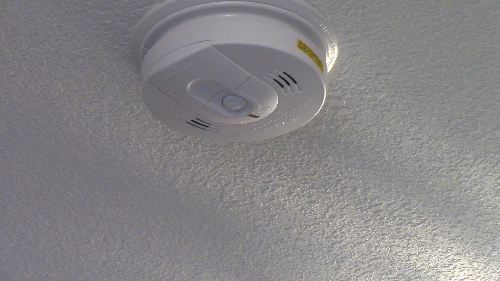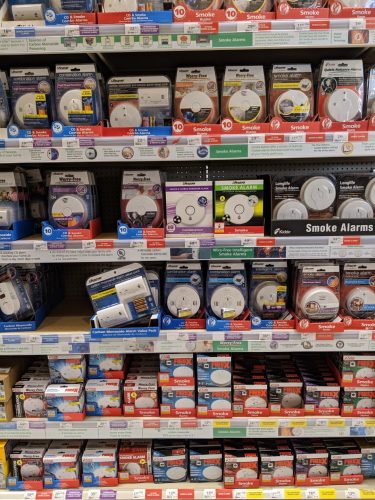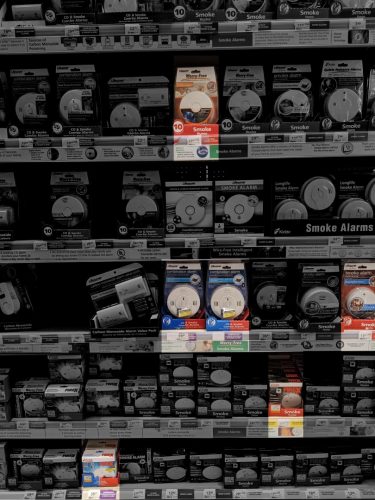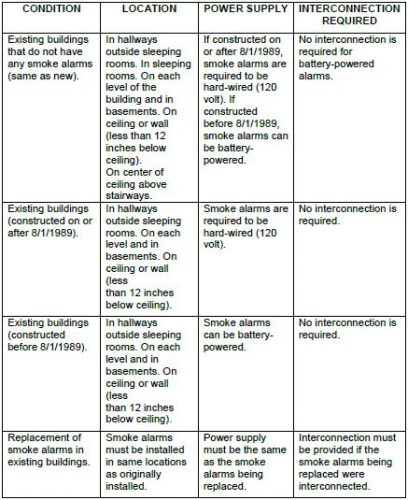Shopping for a new smoke alarm? Stop. Don’t even go to the store until you know exactly which smoke alarm you want. I know the ins and outs of smoke and CO alarms, and I’m still overwhelmed by the selection at home improvement stores.
If you prefer this advice in video format, here’s that:
Get Photoelectric
There are two types of smoke alarm sensors, ionization and photoelectric. I’ll make this very easy for you; only buy smoke alarms with photoelectric sensors. Skip the ionization alarms, and skip the dual-sensor alarms. Check out my old blog post from 2013 for more information on this topic; nothing has changed. Photoelectric smoke alarms are all you need.
Photoelectric smoke alarms say “photoelectric” proudly on the packaging. Ionization alarms don’t. This eliminates a lot of the products out there. I blacked out all of the ionization alarms, dual-sensor alarms, and carbon monoxide alarms (I think). That leaves very few options at this particular retail display, which includes CO/smoke alarm combination units.
Isn’t that easier? And now for your next option.
Smoke/CO combination, or just smoke alarm?
If you’re installing your smoke alarm in the hallway outside of the bedrooms, it makes sense to get a smoke/CO combination alarm. I’ve heard people complain that combination alarms are no good because carbon monoxide alarms are supposed to be installed low to the ground, but that’s not true. CO alarms work just fine when installed high on the wall or on the ceiling.
I’ve also heard people complain that CO alarms only have a shelf life of 5-7 years, but newer ones are good for a full 10 years, just like smoke alarms. So no worry there either.
Hardwired or battery?
If your existing smoke alarm is hardwired, it should be replaced with a hardwired unit. If your smoke alarms are original to the home, the date of construction should help to tell you what type you have. Here’s a handy timeline produced by the Minnesota Department of Public Safety that explains what was required when. Click on the image for a pdf version.
Another simple way to check is to simply detach the smoke alarm from the ceiling and look. Just turn it counter-clockwise and take a peek, like this:

In the clip above, you can clearly see that the smoke alarm is hardwired.
If a hardwired smoke alarm needs to be replaced, it’s no big deal. In fact, it’s so easy that next week’s blog post will consist of a short DIY video showing how it’s done.
Interconnected?
If your smoke alarms aren’t hardwired, they’re probably not interconnected. The benefit to having interconnected smoke alarms is that if one alarm goes off, they all go off. Think of a large home with a smoke alarm in the remote corner of the basement; will the people sleeping in the other corner of the house on the second floor hear that alarm? Will it be loud enough to wake them up? What if there are kids in that room? You get my point. Having interconnected smoke alarms is a good idea.
If your home doesn’t have hardwired smoke alarms, consider purchasing smoke alarms that can be wirelessly paired with each other. These are called wireless smoke alarms.
Sealed battery?
If you need to buy battery-powered smoke alarms, consider one with a sealed lithium-ion battery. These smoke alarms have sealed batteries that never need to be replaced, and are good for the life of the smoke alarm, which is 10 years. This isn’t a critical safety feature, but given the choice, I’d take the sealed battery vs. having to replace my batteries periodically.
What’s important?
You might not be able to purchase exactly what you want, and that’s ok. If you have to split up your smoke and CO alarms to get the most important options, go ahead and do it. Just make sure that you have the most important part covered; get photoelectric smoke alarms.





matt
April 16, 2019, 7:57 am
what do you make of the Nest smoke alarm
Reuben Saltzman
April 16, 2019, 12:49 pm
Hi Matt,
I have no problem with the Nest alarm. It has a photoelectric sensor, so I like it.
bill
April 17, 2019, 8:34 am
Interconnected – you can get wireless alarms that use radio signals to trigger the others. Had them in my old townhouse. All **** would break loose when testing because the other four would start up shortly after triggering one. Got them after being waken up one night by firemen pounding on the door to tell me to get out. Good thing I had fallen asleep watching TV or they would have needed to break the door down to get me from an upper level.
Scott
April 23, 2019, 9:15 am
I am curious about the “In hallways outside sleeping rooms” aspect.
Would it not be better to have them *IN* each of the sleeping rooms?
Or is “in the hallways” meant to be additional to the ones in the sleeping rooms?
Or is having one in each bedroom too much of a burden cost-wise, that this is an acceptable alternative?
If you have a choice, (and by rules/laws), would you rather have 1 in each sleep area, or just one in the hallway outside of the sleep areas?
Reuben Saltzman
April 23, 2019, 4:06 pm
Hi Scott,
Smoke alarms should be installed inside each bedroom and in the hallways outside of sleeping rooms.
My recommendation for a combination smoke/CO unit is only for the units outside of the bedrooms, because in Minnesota, CO alarms are required outside of the bedrooms. It’s ok to install them inside of the bedrooms too, but the only place they’re required is outside.
Is it better to have a smoke alarm inside the bedroom than outside? I can’t say. I definitely recommend both. If I had to choose only one, I’d choose the common area over the bedroom.
Marie
June 11, 2019, 11:47 am
New UL standards coming in 2020 to reduce nuisance alarms.
https://webcache.googleusercontent.com/search?q=cache:NKNEyWUHLWwJ:https://www.ul.com/newsroom/pressreleases/ul-releases-new-requirements-to-smoke-alarm-standards-opens-new-test-lab/+&cd=16&hl=en&ct=clnk&gl=us
According to the National Fire Protection Association (NFPA), nuisance alarms are the leading reason for disconnected smoke alarms. In order to enable manufacturers to produce more responsive alarms that don’t introduce nuisance alarming during cooking, UL conducted a research project to develop data on smoke characteristics during normal cooking events. The research led to new test requirements for cooking alarm tests.
“UL 217 Standard for Smoke Alarms, 8th edition and UL 268 Standard for Smoke Detector Systems, 7th edition raises the bar and research from UL and the fire science community has led the way,” said Barb Guthrie, UL Vice President. “The next generation of smoke alarms and smoke detector systems that comply with the new Standards will be equipped with advanced sensing technology that can reduce smoke alarm activation during a cooking event while allowing smoke alarms to have increased sensitivity and overall performance. And, remember, if your alarm does go off, that means to get down, get out and stay out.”